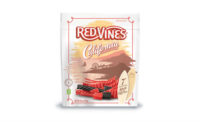When it comes to licorice, texture is king.
Ranging from soft-eating, Australian-style to stiffer, chewier formulations, licorice offers something for every palate, says Joseph Gibilisco, Twizzlers associate brand manager for The Hershey Co.
“It provides a unique texture that tends to be longer lasting than other sweets,” he said. “Consumers also love fun licorice “rope” format. It can be an excuse to ‘play with your food’ and take a break from life’s seriousness.”
There’s also the familiarity factor, says Nicole Bethmann, U.S. general manager for New South Wales, Australia-based Darrell Lea Confectionery Co.
“We’ve all grown up with it. It’s multigenerational,” she said. “People are comfortable with licorice.”
So comfortable, U.S. consumers buy almost half a billion dollars of it annually, data show. IRI, a Chicago-based research firm, reports the licorice category pulled in $453.8 million in the year ending Oct. 8, down 1.41 percent from a year ago. Unit sales just missed 225 million, down 2.84 percent over the same time period.
Twizzlers led the category, with sales topping $217 million over year ending Oct. 8. American Licorice Co.’s Red Vines took the second spot, earning $56.9 million. Rounding out the Top 5 brands and products tracked by IRI are Twizzlers Pull ‘N Peel ($49.2 million), Hershey’s Good & Plenty ($26.3 million) and Twizzlers Nibs ($16.3 million).
Purists often define licorice as having the traditional-yet-polarizing black flavor, and even the classic strawberry flavor, but other combinations are popping up, helping to add variety to the category.
“Most of your licorice consumers will identify licorice — whether it’s Australian or traditional — by red and black. They identify it by color,” Bethmann said. “Those two SKUs are going to do the majority of your sales. What keeps the third and fourth SKUs going are innovation, flavor extensions.”
Darrell Lea — which pulled in $6.8 million over the year ending Oct. 8, according to IRI — recently developed a mixed fruit variety, featuring Apple, Mango and Strawberry bite-sized pieces in a 7-oz. bag. In 2016, the company also launched Stix, bite-sized pieces of Mango and Strawberry licorice with a white chocolate filling.
Nonetheless, Darrell Lea understands where its bread is buttered, Bethmann said.
“Flavors are fun, and they have a purpose in the overall licorice set, but the core business in overall licorice is going to be done in black and red, specifically for Australian licorice,” she said.
Hershey, meanwhile, has been playing with sour straws and fillings to capture younger consumers and to capitalize on the continued popularity of sour flavors.
“With the popularity of bold flavors in the overall sweets category, consumers are seeking similarly bold flavors from licorice, which traditionally has a more mild flavor,” Gibilisco said. “To address this consumer need we’ve seen a rise in flavor delivery for licorice products through fillings and outside coatings.”
In March 2018, Hershey will introduce Twizzlers Sour Mini Twists, which feature a sour outside and a sweet filling in a “two-bite” piece. The company has also introduced Sweet & Sour filled twists and bites in Cherry Kick and Citrus Punch flavors.
And not unlike other categories, licorice manufacturers have developed better-for-you varieties for consumers with particular dietary restrictions and desires.
In 2017, Darrell Lea introduced sugar-free varieties of its original red and black licorice with the goal of serving consumers looking to reduce sugar intake.
“It’s a group of consumers we’ve wanted to engage as a brand — those with sugar sensitivities — but we’ve not been able to do so until recently when we formulated our products with our sugar-free recipe,” Bethmann said.
Also last year, LaPorte, Ind.-based American Licorice Co. introduced Red Vines Made Simple, a “cleaner” take on the company’s classic twists. They’re made with five ingredients — sugar, wheat flour, citric acid, natural flavors and radish extract.
“Red Vines Made Simple is a non-GMO candy made with cane sugar and does not contain any artificial colors or flavors,” says Clint Christensen, Red Vines brand manager. “What surprised many of us is that a lot of people like Red Vines Made Simple better than the original.”
American Licorice also offers sugar-free Red Vines in strawberry and black flavors. And while more candy lovers are seeking gluten-free options, it’s a hurdle licorice manufacturers that use wheat flour in their formulas have not yet crossed.
“We try to look at all dietary trends and assess their impact on our brands,” Christensen said. “That said, celiac and sensitivity to gluten is one that we’ve kept our eye on for awhile. Even though we don’t have a gluten-free licorice under the Red Vines brand yet, it is one of the many trends that we’ve been watching closely.”
However, YumEarth, an organic candy producer based in Stamford, Conn., appears to have cracked the code. Last year, the company introduced black licorice featuring organic rice flour and organic corn starch. The formula is also compliant with California’s Prop 65.
“We like to take on challenges of mainstream ideas and bring them to life,” YumEarth CEO Michael Sands told Candy Industry in June.
Incorporating spice into sweets has also been popular, and Gerrit J. Verburg Co., a Fenton, Michigan-based importer of Gustaf’s Dutch Licorice, has introduced Hot Pepper Trucks, black licorice truck shapes with a spicy liquid filling. It joins a line of original, salted and sugared black licorice enjoyed by die-hard fans, says President Gerrit J. Verburg.
“The people who love it are so loyal and are really looking for our products,” he said. “It’s different enough that people care about it.”
Verburg has also seen success with Allsorts, a mix of brightly-colored licorice pieces believed to be invented in 1899 by Sheffield, England-based Geo. Bassett & Co.
“I see great potential in that item,” Verburg said. “Everybody somehow is familiar with the item, so we can really expand that considerably.”
Whether it’s black or red — or soft or chewy — licorice is a treat that will continue to please. How manufacturers respond to consumers’ wishes and industry trends will depend on how the category is defined.
“We could really drill down to a category and subcategory level better from a syndicated data perspective and get true learnings of what’s going on in our category,” Bethmann said. “If we can become smarter as to how we segment out items, I think our data can become even better as we utilize that for fact-based selling, and we can achieve clearer pictures of what’s really going at retail level.”











